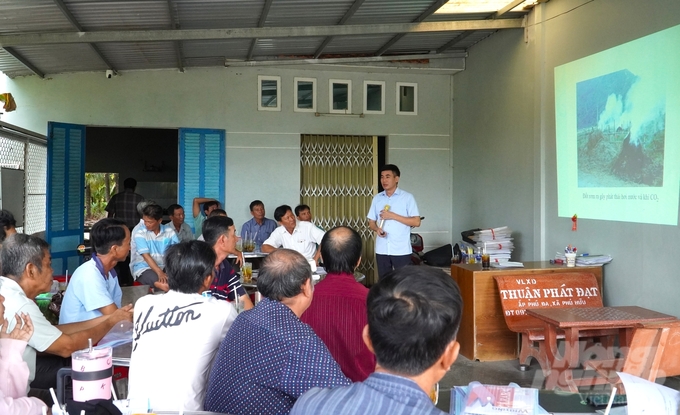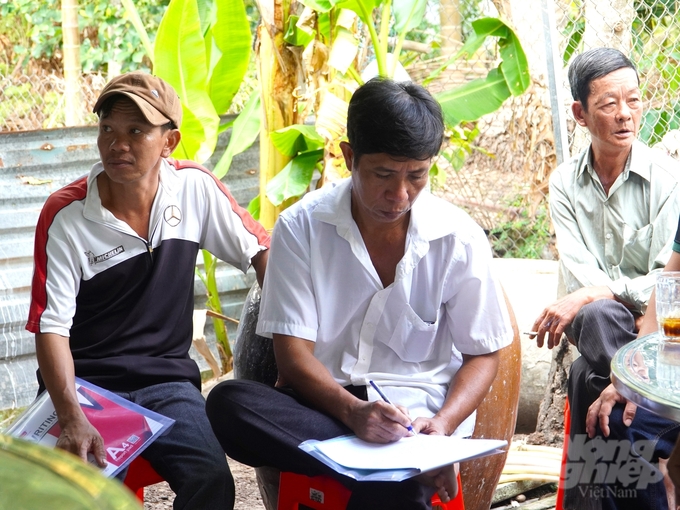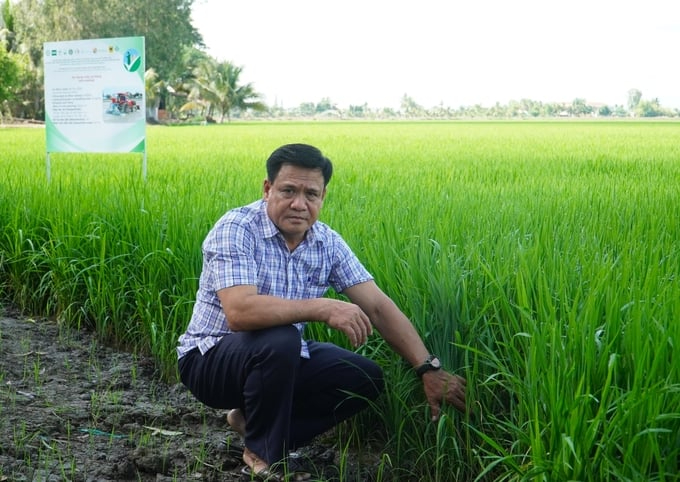June 1, 2025 | 19:26 GMT +7
June 1, 2025 | 19:26 GMT +7
Hotline: 0913.378.918
June 1, 2025 | 19:26 GMT +7
Hotline: 0913.378.918
The first training session of the Training program on the high-quality, low-emission rice farming process for creating pilot models for 1 million ha of high-quality rice project took place on May 17 at the Hung Loi Agricultural Cooperative in Long Phu district, Soc Trang province.
The program executed by NAEC garnered the involvement of 80 farmers, cooperative leaders, agricultural extension personnel, community agricultural extension workers, crop production experts, and plant protection station representatives.
The training class emphasizes the implementation of a high-quality, low-emission rice farming process. It also highlights the role of cooperatives in organizing and facilitating production and consumption relations. Additionally, the program covers MRV technological and process solutions, as well as the application of mechanization in farm cultivation to reduce emissions. A field trip is also included as part of the training.

The training program on high-quality, low-emission rice cultivation processes, implemented by the National Agricultural Extension Center, takes place from May 17 to May 23. Photo: Kim Anh.
Upon receiving instructions, farmer Nguyen Van Ut carefully recorded crucial information regarding the preparatory steps required to participate in the pilot models, to prepare for the upcoming seed-sowing activities.
According to Mr. Ut, the Long Phu area previously cultivated rice thrice annually. Before founding the Hung Loi Agricultural Cooperative, farmers encountered numerous challenges in marketing their rice. Especially when rice prices were high, farmers were very anxious and had to go through two or three intermediaries to sell their rice.
Since its establishment in 2017, the cooperative has facilitated collaboration among farmers in production and has received significant backing from local authorities, ensuring their peace of mind. Presently, Mr. Ut is engaged in the cultivation of approximately 1 hectare of rice. A portion of this land will be involved in a 50-hectare pilot model as part of the 1 Million Hectares of High-Quality Rice Project, which is being executed in Soc Trang province.
Mr. Ut, along with other cooperative members, is highly sure that their current knowledge and manufacturing practices make the implementation of the pilot model rather straightforward.
"Previously, we manually distributed 25-27kg of rice seeds per plot. Approximately three years ago, I transitioned to row sowing. Based on the advice of experts, I currently sow approximately 10-12.5kg of seeds each plot. At first, I experienced significant anxiety due to concerns about potential damage to the field by snails or rats, which could result in insufficient rice yield due to scant seeding. However, after following the recommendations, the rice field surprisingly maintained its yield, and in some cases, even exceeded previous levels," said Mr. Ut.

Members of the Hung Loi Agricultural Cooperative actively participate in training classes, equipping themselves with the knowledge needed to join the 50-hectare pilot model under the 1 Million Hectares of High-Quality Rice Project. Photo: Kim Anh.
Recently, the farmers of the Hung Loi Agricultural Cooperative have implemented a reduction in the number of seeds planted and have consistently employed improved cultivation techniques in accordance with the high-quality rice growing procedure.
With the assistance and transfer of technology from central to local specialized agencies and firms, Mr. Ut is confident that farmers have already experienced the advantages of lowering labor and seed expenses. From a technical standpoint, these farmers do not find this issue troubling and are well capable of handling it.
The training session for the implementation of high-quality rice growing techniques and emission reduction strategies to support the pilot model of the 1 Million Hectares of High-Quality Rice Project is scheduled to occur from May 17 to May 23. The program is concurrently executed in five places selected by the Ministry of Agriculture and Rural Development to establish the pilot model, specifically Soc Trang, Can Tho City, Tra Vinh, Dong Thap, and Kien Giang.

A lecturer from the School of Public Policy and Rural Development (Ministry of Agriculture and Rural Development) shares about the role of cooperatives in organizing, producing, and linking the consumption of high-quality, low-emission rice. Photo: Kim Anh.
According to Mr. Hoang Van Hong, the Deputy Director of the National Agricultural Extension Center, this training program aims to fully impart the necessary knowledge on high-quality rice farming methods to the farmers. This serves as a preliminary measure to assist the cooperatives in adopting the pilot concept.
The following day, on May 18, the training session took place in Thuan Tien Agricultural Cooperative in Thanh An commune, Vinh Thanh district, Can Tho city.
This is the inaugural collaborative initiative to establish a low-emission rice field in the Mekong Delta. It serves as a pilot project for the implementation of a high-quality rice cultivation scheme covering 1 million hectares for the summer-autumn harvest of 2024. The project will be conducted on a 50-hectare scale. Currently, the rice plants have been growing for 43 days and have reached the stage of tillering to booting. It is anticipated that the harvest will take place sometime between July 5 and July 10.

The first low-emission rice field in the Mekong Delta, part of the 1 Million Hectares of High-Quality Rice Project, is developing quite well. Photo: Kim Anh.
According to Mr. Nguyen Cao Khai, the Director of Thuan Tien Agricultural Cooperative, the low-emission rice field is progressing favorably. Leaf roller pests emerged in the field when the rice plants reached an age of 27-28 days. The bugs proliferated rapidly, infesting around 80% of the modeled area, although the amount of infestation was not constant.
The cooperative members showed a strong dedication to adhering to the low-emission rice production method by significantly reducing pesticide spraying before the rice seedlings reached 40 days old. Instead, they engaged in close collaboration with local agricultural extension officers, regularly conducting field visits and inspections to identify pests. Thus far, the cooperative's low-emission rice field remains unaffected by pesticides, resulting in healthy rice that has successfully overcome pest attacks.
Outside the model, the rice fields were heavily seeded with an average of 18-20kg of rice seeds per plot (equal to 1,300 square meters). These fields experienced severe pest assaults. Due to a delayed response to leaf roller insect infestation, farmers were unable to apply pesticides within a three-day period. As a result, up to 90% of the affected area was attacked, resulting in the fields becoming barren and white.
According to Mr. Khai, in the past, farmers would sow rice seeds manually or in rows. During the low-emission rice field project, the farmers became very concerned when the amount of seeds sown each plot was cut to approximately 6kg. Currently, the rice in the model is flourishing, and there is minimal dissatisfaction among individuals.
Although the cooperative members have taken part in the model, they still have a limited understanding of greenhouse gas emissions, carbon credits, and low-emission agricultural practices. Mr. Khai states that the farmers are familiar with the phrases, but they have not provided definitions or comprehended these notions. Hence, this training program is highly advantageous as it integrates practical field models with expert knowledge. Implementing the low-emission agricultural procedure will yield greater practical advantages.
Translated by Linh Linh

(VAN) Several scientists and farmers are experimenting with soil treatment in some key durian-growing regions such as Cai Lay (Tien Giang), Dak Song, Gia Nghia, and Dak R’lap (Dak Nong).
/2025/05/25/4127-3-073637_820.jpg)
(VAN) Thanks to the promotion from an FAO-implemented project, vegetable production in greenhouses in Moc Chau has seen strong development, from 1.5 hectares in 2021 to nearly 50 hectares in 2024.

(VAN) FAO has recently supported USD 140,000 to implement the project 'Risk mitigation human-animal interface risks through disease control initiatives in pig farming.'

(VAN) The People's Committee of Tra Vinh province has approved an adjustment to the investment policy for the Green Hydrogen Plant project, increasing its area to approximately 52.76 hectares.
![Reducing emissions from rice fields: [2] Farmers’ commitment to the soil](https://t.ex-cdn.com/nongnghiepmoitruong.vn/608w/files/news/2025/05/05/dsc08881jpg-nongnghiep-140632.jpg)
(VAN) Clean rice cultivation model in Thuong Tan commune, Bac Tan Uyen district, is assisting local residents in achieving sustainable agriculture by substantially reducing costs, increasing productivity, and protecting the environment.

(VAN) At the conference to disseminate Resolution No. 68, AgriS introduced its digital agricultural ecosystem and reaffirmed its commitment to accompanying the Government in promoting private sector development and sustainable agriculture.

(VAN) 'Blue Ocean - Blue Foods' initiative is designed to restore marine ecosystems and establish sustainable livelihoods for local communities by cultivating a minimum of 1,000 hectares of cottonii seaweed in the first three years.